
A Fresh Look at the Pelican Egg - Historic Connections
The Pelican Egg was presented at Easter 1898 by Tsar Nicholas II to his mother, the Dowager Empress Maria Feodorovna (1847-1928), widow of Tsar Alexander III (1845-1894). It was a gift symbolic of tending the poor, self-sacrificing and nurturing, and it commemorates the establishment in 1787 of The Offices of the Empress Maria, and celebrates the centenary of this event in 1897.
Danish Princess Dagmar, fiancée of Tsesarevich Alexander III, chose at her conversion to orthodoxy the same names as Maria Feodorovna (born Princess Sophie Dorothea of Württemberg, 1759-1828), second wife of Tsar Paul I (1754-1801). It was under the leadership of the first Maria Feodorovna that charity in Russia developed into a government enterprise. Both Tsarinas were patrons of The Offices of the Empress Maria.
The design of this Egg is an excellent example of a gift created by the firm of Fabergé for their Imperial Majesties to commemorate important events in the life of the Russian Empire or the Imperial family.
Charity and Poor Relief
Poverty was, and still often is, one of the key problems of social and economic development worldwide. Imperial Russia was no exception. Before Peter the Great (1672-1725) the major form of poor relief was almsgiving. During his reign spontaneous almsgiving evolved into the creation of public relief institutions.1 Peter the Great founded the first professional education institutes in Moscow. In 1701 the navigational institute was followed by artistic, engineering and hospital schools. After the transfer of the capital to St. Petersburg in 1712, Moscow remained the education center.
The First Foundling Home - The Moscow Orphanage
On September 1, 1763, Empress Catherine the Great (Catherine II - 1729-1796) issued a manifesto for the establishment of the Moscow Orphanage, "a haven for orphans and underprivileged children ... a charitable teaching and educational institution for orphans, foundlings and homeless".2 The first foundling homes were created in Moscow (1764) and in St. Petersburg (1772).

Design of the Orphanage by Architect Karl Blank
In Moscow along the bank of the Moskva River three closed-shell squares with large buildings and courtyards were planned. It was the largest building of Moscow's pre-revolutionary period with a length of the facade on the quay of 379 meters. The western square was for boys, the eastern for girls. A central building connected both, housing administrative quarters and a maternity home. The western square was completed in 1767, the main building in 1771. The eastern wing did not materialize until the 1940's. The Orphanage expanded continuously and architects Domenico and Afanasy Grigoriev designed and built the Board of Trustees building facing Solyanka Street.3
In 1812, during the march of Napoleon on Moscow, the city was hit by the Great Fire. The Moscow Orphanage was saved thanks to local police, yet half of the city and almost half of all the schools were destroyed. They were restored and in the 1830's and 1840's new schools opened. In 1837, the Nicholas Orphanage Institute opened in the complex.
By the mid-19th century, the Orphanage had evolved into "a city within a city" – a largely independent and wealthy institution housing thousands of residents. The emblem of the Moscow Orphanage was a Pelican Feeding its Young, signifying both the love of parents for their children, and care of the sovereign for his people.
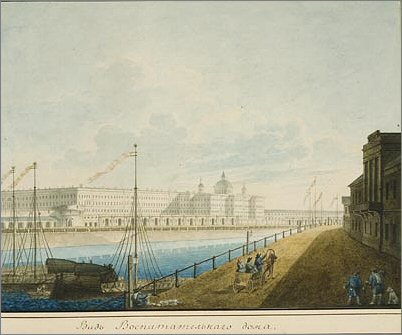
The Moscow Orphanage 1800-1802. Watercolor by an Unknown Artist.
The Offices of the Empress Maria - A Government Department
Emperor Paul, 34 years after his mother's (Catherine the Great) manifesto, in May 1797 centralized the management of the institutions under the auspices of his wife, the Empress Maria Feodorovna. She developed imperial education and charity into an enterprise, equivalent to other departments of government, and actually a new department was added to the emperor's administration. In memory of her, the offices were, first informally and later formally up to 1917, called "The Offices of the Empress Maria”. The Tsarina remained in charge of The Orphanage and similar institutions after her husband's assassination in 1801 until her death in 1828.

Emblem of The Offices of the Empress Maria
Public Taxes to Fund Charity
The Orphanage was run by a Board of Trustees and funded by private donations (including those on behalf of the Imperial Family) and two special taxes - a tax on public theater shows, and a tax on playing cards. For nearly a century, all playing cards sold in Imperial Russia were taxed 5 kopecks per deck on domestic-made cards and 10 kopecks on imports. As a result, every pack of Russian cards displayed the symbol of the Orphanage, a pelican. This tax generated 21,000 rubles in 1796, and 140,000 rubles by 1803.
Cards were played everywhere; in the homes of the Emperor and the Grand Dukes, in aristocratic salons, in taverns and barracks, everywhere that partners could be found. The Dowager Empress Maria Feodorovna, wife of Emperor Paul I, received permission from her son Alexander I (1777-1825) to build a small cards factory, and the money raised was spent on the Imperial Orphanages. In an effort to prevent cheating in aristocratic and nobles' clubs, each new game had to be played with a new sealed pack of cards, and this custom went on to be practiced at the imperial court and in all places laying claim to respectable play. It led to a huge demand for new packs of cards with a double aim in mind - both to resolve the huge deficit of cards which only seemed to grow each year, and to raise funds for charity. In each pack of cards produced in the Imperial Cards Factory, the ace of diamonds was marked with the emblem of the Moscow Orphanage - a Pelican Feeding its Young with its own Blood, and the inscription Spares not herself to feed her young.4
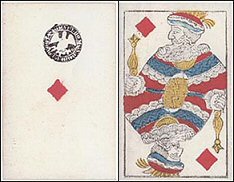 |
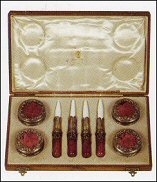 |
Russian Playing Cards with the Pelican Seal
Courtesy The World of Playing Cards |
Fabergé Playing Card Score Set by Julius Rappoport |
The department of The Offices of the Empress Maria expanded steadily until by the turn of the century several hundred orphanages, schools for girls, hospitals and other institutions came under its jurisdiction. Sub-agencies created in the 1880’s administered institutions for the blind and the deaf.


Courtesy Historic Buttons
Officials in charge of education wore uniform buttons with the image of a Pelican Feeding its Young. Those in charge of charity and shelters wore uniforms with the image of growing grapes under sunshine, and the words Visit this Vineyard.5
Philanthropy and Education in the 19th Century
During the 19th century all Empresses followed the example of Maria Feodorovna (wife of Paul I) and focused their activities on philanthropy and education. The spouses of the Emperors, Nicholas I, Alexander II, and Alexander III, continued the patronage of The Offices of the Empress Maria and sponsored the development of education for girls.6
In 1897, the 100th anniversary of The Offices of the Empress Maria was celebrated, as well as the 50th anniversary of the two Nicholas Institutes in Moscow and St. Petersburg.

Courtesy Virginia Museum of Fine Arts
In the 20th century the wife of Tsar Nicholas II, the Empress Alexandra Feodorovna, was engaged in charity too, beginning in the Russo-Japanese War (1904-1905) and later from the first day of the Great War (1914-1918), when she was devoted to nursing and tending the wounded.
On Easter 1915, Tsar Nicholas II presented his mother and his wife each with a Fabergé Easter Egg, both Eggs with the Red Cross theme. It was, as far as is known today, the only year the two Imperial Easter Eggs had the same theme. The Red Cross Tryptich Egg is part of the Minshall Collection, Cleveland Museum of Art. The Red Cross Portraits Egg with Miniatures presented to the Dowager Empress Maria Feodorovna is today, as well the Pelican Egg, in the Collection of the Virginia Museum of Fine Arts.
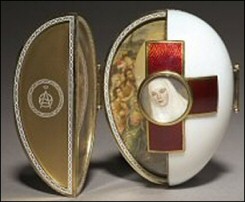
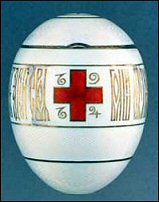
Fabergé Red Cross Easter Eggs Presented in 1915
After the Revolution
On March 4, 1917, The Offices of the Empress Maria was abolished with the subordination of its institutions to the Ministry of Education and was called the Office of the Mariinsky Charitable and Educational Institutions. In May 1917, the former Offices of the Empress Maria were included in the Ministry of Public Welfare. During December 1917, all the institutions of the former Office were abolished and its property and capital nationalized, and on February 23, 1918, transferred to the People's Commissariat of Education.7

Emblem Herzen State Pedagogical University of Russia
With the ending of three hundred years of Romanov rule in 1917 charity as it was known for over one hundred and fifty years in Russia changed. The St. Petersburg Herzen State Pedagogical University of Russia (today housed in many former charitable buildings discussed in this essay) still uses the Pelican Feeding its Young emblem. The Pelican Egg and its miniatures in the Pratt Collection, Virginia Museum of Arts, elegantly tells the story of eight charitable institutions in St. Petersburg and Moscow between 1797-1897.
Other pages:
A Fresh Look at the Pelican Egg - Introduction
A Fresh Look at the Pelican Egg - The Miniatures Explained
References:
1. Philanthropy in Imperial Russia from the 18th to the Early 20th Century - Galina Ulianova, Institute of Russian History, Russian Academy of Sciences, Moscow, Russia. http://www.history.ac.uk/ihr/Focus/welfare/articles/ulianovag.html
2. Moscow Orphanage Miloserdie.ru: http://www.miloserdie.ru/index.php?ss=2&s=12&id=5456
3. In 1990 during construction work on Solyanka Street, two tin candy boxes with jewels were found, and later identified as the work of Karl Fabergé. See von Habsburg/Lopato, Fabergé: Imperial Jeweller, 1993, 148-51.
4. Galina Mirolubova, "Playing Cards at the Russian Court" in At the Russian Court - Palace and Protocol in the 19th Century, Hermitage Amsterdam, 2009, 278. (Ace of hearts should read ace of diamonds)
5. Historical Buttons: www.pugoviza.ru
6. Robin Bisha, Russian Women, 1698-1917: Experience and Expression: an Anthology of Sources, 2002, 9.
7. The Offices of the Empress Maria: http://encblago.lfond.spb.ru/showObject.do?object=2815934832
Webpages last visited and information retrieved: March 15, 2010.
Page updated: January 8, 2019 4:05 PM
